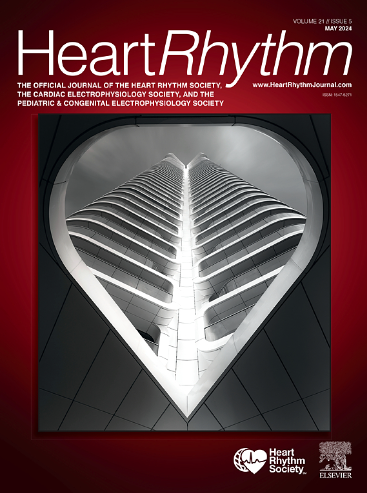心房颤动导管消融后左心耳关闭和口服抗凝的比较:OPTION随机对照试验的伴随队列和序贯队列
IF 5.7
2区 医学
Q1 CARDIAC & CARDIOVASCULAR SYSTEMS
引用次数: 0
摘要
背景:LAAC可以与心脏消融(顺序)分开进行,也可以在同一手术期间同时进行。目的:OPTION试验旨在比较LAAC与OAC在房颤导管消融患者中的疗效和安全性。亚分析是评估LAAC与OAC在伴随和顺序消融时间内的对比。方法:OPTION是一项多中心、前瞻性随机临床试验。接受导管消融的房颤和CHA2DS2-VASc评分升高的患者被随机(1:1)分配到基于导管的LAAC(装置)和口服抗凝(对照组)。随机化按房颤导管消融手术时间分层:顺序(随机化前90至180天)或伴随(随机化后10天内);随机化,99%的手术在同一天进行)。主要安全终点是非程序性大出血或临床相关的非大出血。主要疗效终点为全因死亡、中风或全身性栓塞;36个月。结果:在合并组(n=654)和序贯组(n=946)中,与对照组相比,器械组的主要安全终点事件较少,主要疗效事件和次要安全事件的发生率相似。在伴随组中,装置组和对照组的急性安全事件发生率较低且相似;在心脏消融过程中加入LAAC并不会导致程序性事件的增加。结论:对于合并和序贯消融时机策略,LAAC与OAC相比具有相似的疗效,并且对于房颤消融后高危患者临床上重要的术后出血风险更低。本文章由计算机程序翻译,如有差异,请以英文原文为准。
Comparison of left atrial appendage closure and oral anti-coagulation after catheter ablation for atrial fibrillation: Concomitant and sequential cohorts of the OPTION randomized controlled trial
Background
Left atrial appendage closure (LAAC) can be performed in separate procedures with cardiac ablation (sequentially) or concomitantly in the same operative session.
Objective
The OPTION trial aims to compare the efficacy and safety of LAAC with oral anticoagulation (OAC) in patients who have undergone catheter ablation for atrial fibrillation (AF). The objective of this sub-analysis is to evaluate LAAC vs OAC within concomitant and sequential ablation timings.
Methods
OPTION is a multicenter, prospective randomized clinical trial. Patients with AF and an elevated CHA2DS2-VASc score undergoing catheter ablation were randomly assigned (1:1) to catheter-based LAAC (Device) vs OAC (Control). Randomization was stratified by AF catheter ablation procedure timing: Sequential (90–180 days prior to randomization) or Concomitant (within 10 days of randomization, 99% of procedures happened the same day). The primary safety end point was non-procedural major or clinically-relevant non-major bleeding. The primary efficacy end point was the composite of all-cause death, stroke, or systemic embolism at 36 months.
Results
In both the Concomitant (n = 654) and Sequential (n = 946) groups, the Device arm compared with Control had fewer primary safety end point events and similar rates of primary efficacy events and secondary safety events. Rates of acute safety events were low and similar between the Device and Control arms within the Concomitant group; the addition of LAAC to cardiac ablation sessions did not result in increased procedural events.
Conclusions
For both Concomitant and Sequential ablation timing strategies, LAAC has similar efficacy compared with OAC and a lower risk of clinically important post-procedure bleeding in high-risk patients following AF ablation.
求助全文
通过发布文献求助,成功后即可免费获取论文全文。
去求助
来源期刊

Heart rhythm
医学-心血管系统
CiteScore
10.50
自引率
5.50%
发文量
1465
审稿时长
24 days
期刊介绍:
HeartRhythm, the official Journal of the Heart Rhythm Society and the Cardiac Electrophysiology Society, is a unique journal for fundamental discovery and clinical applicability.
HeartRhythm integrates the entire cardiac electrophysiology (EP) community from basic and clinical academic researchers, private practitioners, engineers, allied professionals, industry, and trainees, all of whom are vital and interdependent members of our EP community.
The Heart Rhythm Society is the international leader in science, education, and advocacy for cardiac arrhythmia professionals and patients, and the primary information resource on heart rhythm disorders. Its mission is to improve the care of patients by promoting research, education, and optimal health care policies and standards.
 求助内容:
求助内容: 应助结果提醒方式:
应助结果提醒方式:


